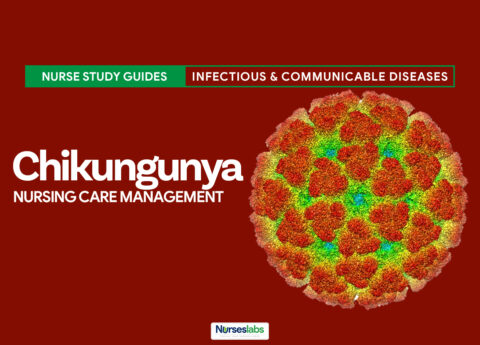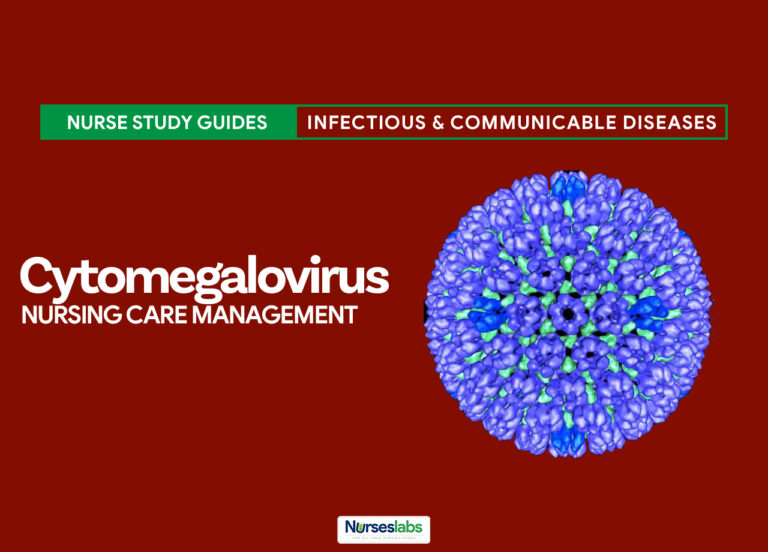This study guide will give an overview of the Zika virus, including its transmission, symptoms, diagnosis, treatment, prevention, and nursing management.
Zika virus was first identified in the Zika forest of Entebbe, Uganda in 1947 when a group of scientists examined a febrile rhesus monkey for Yellow fever. This infectious disease has been linked to incidences of microcephaly (babies being born with underdeveloped brains), Guillain-Barré syndrome, myelitis, and other neurologic conditions.
What is the Zika virus?
Zika virus is a mosquito-borne flavivirus that is transmitted to humans primarily through the bite of an infected Aedes species mosquito (Aedes aegypti and Aedes albopictus).
- The Zika virus (ZIKV) is a member of the Flaviviridae virus family and the Flavivirus genus.
- In most cases, Zika virus infection causes a mild, self-limited illness.
- The incubation period is likely 3-12 days.
- The spectrum of Zika virus disease overlaps with other of arboviral infections, but rash (maculopapular and likely immune-mediated) typically predominates.
- In April 2016, a deputy director at the Centers for Disease Control and Prevention (CDC) warned that the risk of Zika virus infection in the United States may have been previously underestimated, citing the increased range of the mosquito vectors (now in 30 US states, up from 12 as previously thought) and the travel risks associated with the 2016 Olympics in Brazil.
- Nonhuman and human primates are likely the main reservoirs of the virus, and anthroponotic (human-to-vector-to-human) transmission occurs during outbreaks.
Pathophysiology
Zika virus is well-adapted to grow in various hosts, ranging from arthropods to vertebrates.
- Viral attachment to unidentified cellular receptors is mediated by the E (envelope) glycoprotein.
- This is followed by endocytic uptake and then uncoating of the nucleocapsid and release of viral RNA into the cytoplasm.
- A viral polyprotein is produced and modified by the endoplasmic reticulum.
- Immature virions collect both in the endoplasmic reticulum and in secretory vesicles before being released.
Causes
Zika virus is transmitted to people primarily through the bite of an infected Aedes species mosquito (Ae. aegypti and Ae. albopictus).
- Mosquitoes. A mosquito gets infected with a virus when it bites an infected person during the period of time when the virus can be found in the person’s blood, typically only through the first week of infection; infected mosquitoes can then spread the virus to other people through bites.
- Infected pregnant mother to child. A pregnant woman already infected with Zika virus can pass the virus to her fetus during pregnancy or around the time of birth.
- Through sex. Zika can be passed through sex from a person who has Zika to his or her partner; Zika can be passed through sex, even if the infected person does not have symptoms at the time.
- Through blood transfusion. There have been multiple reports of possible blood transfusion transmission cases in Brazil.
- Through lab and healthcare setting exposure. There are reports of laboratory-acquired Zika virus infections, although the route of transmission was not clearly established in all cases.
Statistics and Incidences
The global prevalence of Zika virus infection has not been widely reported owing to its asymptomatic clinical course, clinical resemblance to other infections with other flaviviruses (dengue, chikungunya), and difficulty in confirming the diagnosis.
- In 2015 and 2016, large outbreaks of Zika virus occurred in the Americas, resulting in an increase in travel-associated cases in US states, widespread transmission in Puerto Rico and the US Virgin Islands, and limited local transmission in Florida and Texas.
- Based on sporadic case reports, entomological surveys, and seroprevalence surveys, Zika virus infection had been reported in various hosts, including humans, primates, and mosquitoes, in 14 countries across Africa, Asia, and Oceania, as of 2014.
- In May 2015, Brazil reported the first outbreak of Zika virus infection in the Americas.
- The Brazil Ministry of Health estimated around 440,000-1,300,000 suspected cases of Zika virus infection in December 2015.
- In March 2016, the WHO reported that the Zika virus was actively circulating in 38 countries and territories, 12 of which have reported an increase in GBS cases or laboratory evidence of Zika virus among patients with GBS.
- As of June 2016, a total of 591 laboratory-confirmed travel-associated Zika virus infections have been reported in the United States, with none acquired via local vector-borne transmission.
Clinical Manifestations
Many people infected with the Zika virus won’t have symptoms or will only have mild symptoms. The most common symptoms of Zika are:
- Fever. One of the most common and early signs of Zika is fever, which may occur within the first week of illness.
- Rash. The rash in Zika virus infection is usually a fine maculopapular rash that is diffusely distributed; it can involve the face, trunk, and extremities, including palms and soles; occasionally, the rash may be pruritic.
- Headache. Retroocular headache is a symptom of Zika virus.
- Joint pain. Arthralgia involving the small joints of the hands and feet is also a common symptom of the Zika virus.
- Conjunctivitis (red eyes). Viral conjunctivitis in Zika is also self-limiting.
- Muscle pain. Muscle pain may last for 2 to 7 days just like the other symptoms.
Assessment and Diagnostic Findings
Diagnostic testing for Zika virus infection can be accomplished using both molecular and serologic methods.
- Nucleic acid amplification test. Nucleic acid amplification test, or NAAT, is a generic term referring to all molecular tests used to detect viral genomic material; NAAT assays are the preferred method of diagnosis because they can provide confirmed evidence of infection.
- Zika virus antibody testing. IgM levels are variable, but generally become positive starting in the first week after the onset of symptoms and continuing for up to 12 weeks post-symptom onset or exposure, but may persist for months to years.
- Plaque reduction neutralization tests (PRNT). Plaque reduction neutralization tests (PRNT) are quantitative assays that measure virus-specific neutralizing antibody titers. PRNTs can resolve false-positive IgM antibody results caused by non-specific reactivity and at times help identify the infecting virus.
Medical Management
There is no specific medicine or vaccine for Zika virus.

- Medical care. Supportive care with rest and adequate fluid hydration is advised; symptoms such as fever and pain can be controlled with acetaminophen.
- Consultations. Expert consultation with maternal-fetal medicine and infectious diseases specialists is advised for management of Zika virus infection during pregnancy.
- Prevention. The best method for preventing Zika virus infection is to avoid travel to areas with active Zika virus transmission; different strategies to prevent mosquito bites include wearing full-sleeved shirts and long pants, sleeping under mosquito bed net, and treating clothing with permethrin.
Nursing Management
Nursing care in a patient with Zika virus includes the following:
Nursing Assessment
Assessment of a patient with Zika virus includes:
- History. The incubation period is likely 3-12 days; owing to the mild nature of the disease, more than 80% of Zika virus infection cases likely go unnoticed; the spectrum of Zika virus disease overlaps with other that of arboviral infections, but rash (maculopapular and likely immune-mediated) typically predominates.
- Physical exam. The WHO recommends that newborns born to mothers with Zika virus infection undergo head circumference measurement between 1 and 7 days after birth; ahead circumference of more than 2 standard deviations below the mean is considered microcephaly; a circumference of more than 3 standard deviations below the mean is classified as severe microcephaly, which should prompt neuroimaging.
Nursing Diagnosis
Based on the assessment data, the following are the nursing diagnosis for a patient with Zika virus:
- Acute pain related to severe retroocular headaches. and joint pain.
- Hyperthermia related to increased metabolic rate and dehydration.
- Fluid volume deficit related to excessive sweating and dehydration.
- Knowledge deficit related to lack of exposure and information about the disease process, its treatment, and prognosis.
Nursing Care Planning and Goals
The major nursing care planning goals for a patient with Zika virus include:
- Patient describes satisfactory pain control at a level less than 3 to 4 on a rating scale of 0 to 10.
- Patient maintains body temperature below 39° C (102.2° F).
- Patient explains measures that can be taken to treat or prevent fluid volume loss.
- Patient and folks explain disease state, recognizes need for medications, and understands treatments.
Nursing Interventions
Below are the nursing interventions for a patient with Zika virus:
- Relieve pain. Acknowledge reports of pain immediately; get rid of additional stressors or sources of discomfort whenever possible; provide rest periods to promote relief, sleep, and relaxation; determine the appropriate pain relief method; provide analgesics as ordered, evaluating the effectiveness and inspect for any signs and symptoms of adverse effects.
- Decrease fever. Eliminate excess clothing and covers; give antipyretic medications as prescribed; encourage ample fluid intake by mouth; provide high caloric diet or as indicated by the physician; and educate patient and family members about the signs and symptoms of hyperthermia and help in identifying factors related to the occurrence of fever; discuss the importance of increased fluid intake to avoid dehydration.
- Provide adequate fluid volume. Urge the patient to drink prescribed amount of fluid; emphasize importance of oral hygiene; provide comfortable environment by covering patient with light sheets; administer parenteral fluids as prescribed; consider the need for an IV fluid challenge with immediate infusion of fluids for patients with abnormal vital signs; provide measures to prevent excessive electrolyte loss (e.g., resting the GI tract, administering antipyretics as ordered by the physician); teach family members how to monitor output in the home; instruct them to monitor both intake and output.
- Educate patient and significant others. Grant a calm and peaceful environment without interruption; provide an atmosphere of respect, openness, trust, and collaboration; include the patient in creating the teaching plan, beginning with establishing objectives and goals for learning at the beginning of the session; provide clear, thorough, and understandable explanations and demonstrations; when presenting a material, start with the basics or familiar, simple, and concrete information to less familiar, complex ones; and allow repetition of the information or skill.
Evaluation
Nursing goals are met for a patient with Zika virus as evidenced by:
- Patient described satisfactory pain control at a level less than 3 to 4 on a rating scale of 0 to 10.
- Patient maintained body temperature below 39° C (102.2° F).
- Patient explained measures that can be taken to treat or prevent fluid volume loss.
- Patient and folks explained disease state, recognizes need for medications, and understands treatments.
Documentation Guidelines
Documentation in a patient with Zika virus includes:
- Individual findings, including factors affecting, interactions, nature of social exchanges, specifics of individual behavior.
- Cultural and religious beliefs, and expectations.
- Plan of care.
- Teaching plan.
- Responses to interventions, teaching, and actions performed.
- Attainment or progress toward the desired outcome.
Summary
Here are some of the most important points about Zika virus:
- Zika virus was first described in a febrile rhesus monkey in the Zika forest of Entebbe, Uganda, and was reported to a human field worker shortly thereafter.
- Zika virus is transmitted to humans primarily through the bite of an infected Aedes species mosquito (Ae. aegypti and Ae. albopictus); the incubation period is likely 3-12 days.
- A pregnant woman already infected with Zika virus can pass the virus to her fetus during pregnancy or around the time of birth.
- In 2015 and 2016, large outbreaks of Zika virus occurred in the Americas, resulting in an increase in travel-associated cases in US states, widespread transmission in Puerto Rico and the US Virgin Islands, and limited local transmission in Florida and Texas.
- The most common symptoms of Zika are fever, rash, headache, joint pain, conjunctivitis, and muscle pain.
- Diagnostic testing for Zika virus infection can be accomplished using both molecular and serologic methods.
- Supportive care with rest and adequate fluid hydration is advised; symptoms such as fever and pain can be controlled with acetaminophen.
References
Sources and references for this Zika virus study guide:
- Navalkele, BD, MD. (2018, Dec 11). Zika Virus. Retrieved from https://emedicine.medscape.com/article/2500035-overview
- Centers for Disease Control and Prevention. (2019, Nov 20). Zika Virus. Retrieved from https://www.cdc.gov/zika/index.html





































Leave a Comment